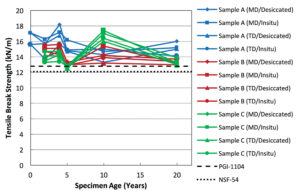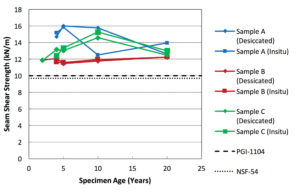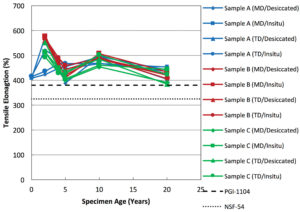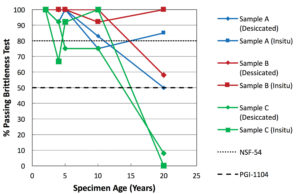Introduction
The Fabricated Geomembrane Institute (FGI), formerly the PVC Geomembrane Institute, in collaboration with the Minnesota Department of Natural Resources (Minn. DNR), has been conducting a study assessing the long-term durability of PVC geomembranes.
Samples of three different 30-mil PVC geomembranes were placed at the bottom of a settling basin near the northern Minnesota town of Hibbing in October 1995 with the intention of extracting samples for testing after 2, 4, 5, 10, 20, 25, and 30 years. This update showcases the results from the first 20 years of the program.
Geomembrane sample designation and preparation
This ongoing project is investigating the 30-year durability of PVC geomembranes, PVC chemical fusion, and hot-wedge–welded seams. Three 30-mil geomembranes from three different manufacturers were placed at the bottom of a double-lined water treatment settling basin at a Minn. DNR field research site in Hibbing in October 1995. The extreme weather fluctuations and harsh winters with annual freeze/thaw cycles in Hibbing provided an excellent place to really test the durability of the materials.
The settling basin contains mine waste rock drainage that has been treated to neutralize acid and precipitate metals. Three PVC test strips, originally 6ft wide and 50ft long, were installed. Following exhumations and sampling events after 2, 4, 5, 10, and 20 years, the tests strips are shorter now but the remainder of the strips are still buried below a 6-in. sand cover at the bottom of the basin. Each test strip contains a single seam that runs the entire length at the centerline of the strip. Two of the strips have chemical seams and the other has a 1.5-in. single wedge-welded seam. Given the size of the basin, additional materials (e.g., polypropylene, linear low-density polyethylene, and Elvaloy) are being considered for installation during summer 2017 to expand the study.
The 30-mil PVC geomembranes employed in this study are identified as (1) Sample A,
manufactured by Occidental Chemical Corp. of Burlington, N.J.; (2) Sample B, manufactured by Nanya Plastics of Carson, Calif.; and (3) Sample C, manufactured by Canadian General Tower of Cambridge, Ont., Canada.
Each material was used to make the test strips with seams running down the middle where the transverse direction (TD) of the material is parallel with the 50-ft length of each test strip and the machine direction (MD) is perpendicular to the seam. For Samples A and C the seam is a standard chemical weld, while Sample B’s is a 1.5-in. single wedge-welded seam.
The strips were placed at the bottom of the pond and covered with 6in. of sand. The average water depth of the pond is about 3.5ft and can completely freeze during the winter months depending on the water depth, which varies from 0.5 to 8ft. The basin pond receives treated waste rock drainage from the on-site treatment system as well as precipitation that falls over the basin.

Samples used for testing are obtained by draining the pond, uncovering the test strips, and cutting 30in. × 6ft section of each material (photo, right). The samples were immediately rolled and wrapped in heavy-duty plastic to preserve as much of the in-situ moisture as possible. Then the sealed geomembrane samples were shipped by overnight courier to the University of Illinois. Upon arrival at the testing laboratory, the sealed samples were stored in a moisture-controlled room.
In preparation for testing, each sample was wiped clean with a damp cloth and cut into three pieces: a 1ft (MD) × 30in. (TD) strip containing the 1.5-in. seam and two 30-in. (MD) × 30-in. (TD) squares.
One of the squares and half of the seam strip were then taken out of the moisture-controlled room to desiccate while the other half was once again wrapped in plastic. These two sets were subsequently labeled either desiccated or in situ. Before testing a set of specialty steel dies and a hydraulic press were used to cut the samples to ensure dimensional uniformity.
Lab testing
A total of nine different tests were run on each material along both the machine and transverse directions: (1) thickness (ASTM D5199); (2) tensile strength at break, elongation at break, and strength at 100% strain (ASTM D882, Method A); (3) tear strength (ASTM D1004); (4) dimensional stability (ASTM D1204); (5) low temperature impact (ASTM D1790); (6) water extraction (ASTM D1239); (6) volatile loss (ASTM D1203); (7) hydrostatic resistance (ASTM D751); (8) seam shear strength (ASTM D882, Method A); and (9) seam peel strength (ASTM D882).
 ASTM recommends the desiccation of samples prior to testing. All testing was run on specimens as close to field moisture conditions and after a week of desiccation at room temperature. The properties determined by these tests were then compared against reference values from both the NSF-54 and FGI 1115 (formerly PGI 1104) standards.
ASTM recommends the desiccation of samples prior to testing. All testing was run on specimens as close to field moisture conditions and after a week of desiccation at room temperature. The properties determined by these tests were then compared against reference values from both the NSF-54 and FGI 1115 (formerly PGI 1104) standards.
After 20 years of exposure, the material properties of the three membranes still mostly exceed the minimum specifications. Figure 1 shows the results of the tensile break strength tests, where the 20-year strength is close to that measured after five years of exposure and both still meet the NSF-54 and FGI 1115 specifications.
 Figure 2 presents the results of the seam shear tests, which shows that both the chemical and hot-wedge–welded seams still perform well in excess of the specification. When the chemical seams were made, it was neglected to leave loose flaps of material, which prevented the performance seam peel tests. The hot-wedge seam on Sample B does have loose flaps, but previous investigators did not report any data. The seam tests were performed on both desiccated and in-situ samples. The desiccated and in situ samples exhibited peel strength of 4.8 kN/m and 6.2 kN/m respectively, which are well above the PGI 1115 specification of 2.6 kN/m.
Figure 2 presents the results of the seam shear tests, which shows that both the chemical and hot-wedge–welded seams still perform well in excess of the specification. When the chemical seams were made, it was neglected to leave loose flaps of material, which prevented the performance seam peel tests. The hot-wedge seam on Sample B does have loose flaps, but previous investigators did not report any data. The seam tests were performed on both desiccated and in-situ samples. The desiccated and in situ samples exhibited peel strength of 4.8 kN/m and 6.2 kN/m respectively, which are well above the PGI 1115 specification of 2.6 kN/m.
For comparison purposes, Figure 3 shows the percent elongation at break from the tensile strength tests. The data shows a trend of decreasing ductility with time compared to the 10-year results. In particular, desiccated Sample C  in the machine direction (MD) exhibits an elongation at break of 384%, which is close to falling below the FGI specification of a minimum of 380%. When the test was repeated at in-situ conditions, the observed elongation for Sample C
in the machine direction (MD) exhibits an elongation at break of 384%, which is close to falling below the FGI specification of a minimum of 380%. When the test was repeated at in-situ conditions, the observed elongation for Sample C
in the machine direction (MD) was 444%.
One geomembrane index property that underwent a significant deterioration since the previous testing window in 2005 was the resistance to low temperature impact at –29˚C (–20.2˚F). This test is conducted by introducing folded strips of geomembrane into a freezer, letting them acclimate to –29˚C, and then dropping a hammer on the fold in the geomembrane. If the sample does not shatter at the fold, it passes the test. Samples A and B showed better performance at in-situ moisture test condition than the desiccated specimens.
 The specimens of Samples A and B at in-situ water conditions exceeded the FGI and NSF specifications requiring 50% and 80% passage, respectively, as shown in Figure 4. Samples A and B under in-situ moisture test conditions performed better than the desiccated specimens, but both pass or are in agreement with the FGI specification.
The specimens of Samples A and B at in-situ water conditions exceeded the FGI and NSF specifications requiring 50% and 80% passage, respectively, as shown in Figure 4. Samples A and B under in-situ moisture test conditions performed better than the desiccated specimens, but both pass or are in agreement with the FGI specification.
In the case of Sample A, desiccating the specimen prior to testing, as specified in ASTM D1790, resulted in only 50% passing the requirement, while 85% of the in-situ samples passed. Figure 4 also shows that Sample C did not pass at the in-situ testing condition and 98% of the desiccated samples also did not pass the FGI specification.
Both of these results are well below the 50% required for passing the FGI specification. These tests were conducted twice with samples taken from different parts of the 20-year exhumed geomembrane to confirm the results. The increased failure rate could be related to the decrease in both tensile break strength and percent elongation at break that was observed, which is indicative of decreased ductility, potentially caused by some plasticizer migration. However, the geomembrane was still quite flexible and easily rolled into a tight roll for sealing and shipping.
Summary
After 20 years of exposure in this ongoing investigation, the laboratory test results show that, generally, the material properties of three different PVC geomembranes exceed the initial specification. The specimens tested at the in-situ moisture condition are more representative of the field performance and durability than the desiccated moisture condition, because the geomembrane is not desiccated in this field application (a settling basin).
In particular, most of the test results for specimens tested at the in-situ moisture and laboratory-desiccated moisture conditions exceed the NSF-54 and PGI-1104 specifications. However, after 20 years of exposure in this harsh environment in northern Minnesota, some of the index properties are decreasing/changing and moving toward the specified limit.
Timothy D. Stark is a professor of civil engineering at the University of Illinois/Urbana–Champaign.
Rodrigo Fernandez is an undergraduate research assistant at the University of Illinois/Urbana–Champaign.
Zach Wenz is a research scientist with the Minnesota Department of Natural Resources.
Steve Koski is a research scientist with the Minnesota Department of Natural Resources.
References
- ASTM D882, “Standard Test Method for Tensile Properties of Thin Plastic Sheeting,” American Society for Testing and Materials, Vol. 08.01, West Conshohocken, Pa., USA.
- ASTM D1004, “Standard Test Method for Initial Tear Resistance of Plastic Film and Sheeting,” American Society for Testing and Materials, Vol. 08.01, West Conshohocken, Pa., USA.
- ASTM D1203, “Standard Test Methods for Volatile Loss from Plastics Using Activated Carbon Methods,” American Society for Testing and Materials, Vol. 08.01, West Conshohocken, Pa., USA.
- ASTM D1204, “Standard Test Method for Linear Dimensional Changes of Nonrigid Thermoplastic Sheeting or Film at Elevated Temperature,” American Society for Testing and Materials, Vol. 08.01, West Conshohocken, Pa., USA.
- ASTM D1239, “Standard Test Method for Resistance of Plastic Films to Extraction by Chemicals,” American Society for Testing and Materials, Vol. 08.01, West Conshohocken, Pa., USA.
- ASTM D-1790, “Standard Test Method for Brittleness Temperature of Plastic Sheeting by Impact,” American Society for Testing and Materials, Vol. 08.02, West Conshohocken, Pa., USA.
- ASTM D-3083, “Standard Specification for Flexible Poly (Vinyl Chloride) Plastic Sheeting for Pond, Canal, and Reservoir Lining,” American Society for Testing and Materials, Vol. 08.02, West Conshohocken, Pa., USA.
- FGI (Fabricated Geomembrane Institute) (2015), “Specifications for PVC Geomembranes 1115,”
University of Illinois at Urbana–Champaign. - National Sanitation Foundation (NSF) International Standard 54-1993, Flexible Membrane Liners,
Ann Arbor, Mich., 30 p., telephone: (734) 975-8670. - Newman, E. J., and Stark, T. D. (2009). Ten-year PVC geomembrane durability. Geosynthetics International 16, No. 2, 97–108. [doi: 10.1680/gein.2009.16.2.97].
 TEXTILES.ORG
TEXTILES.ORG



This article references many ASTM standard, but I’m curious why they wouldn’t use the most current industry standard ASTM test methods for PVC Geomembranes?(See Below)
I would be curious to see how the test results actually compared to the real ASTM Standard that the industry actually recognizes…
ASTM D7176-06(2011) Standard Specification for Non-Reinforced Polyvinyl Chloride (PVC) Geomembranes Used in Buried Applications
ASTM D7408-12 Standard Specification for Non Reinforced PVC (Polyvinyl Chloride) Geomembrane Seams